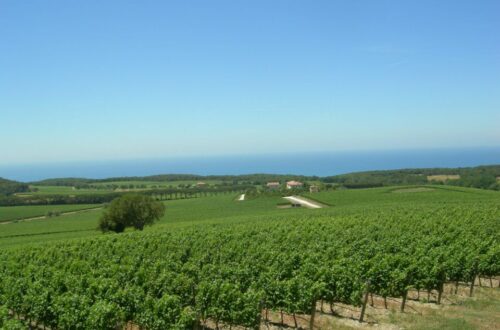Table of Contents
What is Barletta DOC?
Barletta DOC is a wine appellation in northern Puglia, Italy, established in 1977. Known for its bold Uva di Troia–based red wines, fresh rosés, and fragrant Malvasia whites, it carries a unique cultural heritage tied to the legendary Disfida di Barletta, a medieval duel that symbolizes local pride. Today, Barletta DOC is celebrated as one of southern Italy’s most historic wine regions, offering excellent value and a strong sense of place.
The Legend of the Disfida di Barletta
Few wine regions can claim a medieval duel as part of their identity. In 1503, during the Italian Wars, 13 Italian knights faced 13 French challengers just outside Barletta. Known as the Disfida di Barletta (Challenge of Barletta), the Italians triumphed, and the story has become a cornerstone of Barletta’s cultural pride.
Wine was present then too—chronicles tell of Italian soldiers gathering in Barletta’s taverns, drinking local reds before battle. Today, this legend lives on in Cantina della Disfida, a historic tavern, and in festivals that celebrate courage, heritage, and the wines of Barletta.
Geography & Puglia Terroir
Located on Puglia’s Adriatic coast, Barletta DOC spans four municipalities: Barletta, Trani, Andria, and Margherita di Savoia. The terroir reflects Puglia’s dual character:
- Climate: Hot, sunny Mediterranean with cooling sea breezes.
- Soils: Limestone, clay, and sandy coastal soils that stress vines, concentrating flavor.
- Effect: Uva di Troia thrives here, developing structured tannins and dark fruit intensity, while Malvasia Bianca gains aromatic lift.
Barletta’s terroir makes it one of the most distinctive southern Italian wine regions, bridging inland structure with maritime freshness.
Uva di Troia: The Hero Grape
At the heart of Barletta DOC is Uva di Troia (pronounced OO-va dee TROY-ah), an indigenous Puglian red variety.
- Characteristics: Thick-skinned, late-ripening, naturally high in tannins.
- Flavor Profile: Black cherry, plum, violets, leather, and spice.
- Winemaking Potential: Produces robust, age-worthy wines but also adapts well to blends.
Compared to Sangiovese, it has darker fruit and firmer tannins; compared to Aglianico, it is slightly softer and more aromatic.
Wine Styles & DOC Regulations
Rosso Barletta
- Blend: Minimum 70% Uva di Troia, plus Montepulciano, Sangiovese, Malbec, or Trebbiano.
- Style: Deep ruby, full-bodied, structured.
- Aging: Riserva requires 2 years (including 1 in oak).
Rosato
- Blend: Uva di Troia base.
- Style: Vibrant, dry rosé with red berry freshness and herbal notes—perfect for summer.
Bianco (Malvasia)
- Blend: Primarily Malvasia Bianca, sometimes blended with Trebbiano.
- Style: Floral, crisp, Mediterranean white with citrus and almond hints.
Riserva
- Style: Concentrated, barrel-aged Uva di Troia wines with great depth, suitable for cellaring 5–10 years.
Key Facts at a Glance
- Established: 1977
- Location: Northern Puglia, Adriatic coast
- Main Grapes: Uva di Troia (red), Malvasia Bianca (white)
- Styles: Red, Rosé, White, Riserva
- Climate: Hot Mediterranean with sea influence
- Soil: Limestone-clay, coastal sand
- Unique Feature: Linked to the medieval Disfida di Barletta duel
Tasting Notes & Characteristics
- Red (Rosso): Black cherry, plum, licorice, tobacco, firm tannins, medium-high acidity.
- Rosato: Strawberry, pomegranate, Mediterranean herbs, refreshing minerality.
- Bianco: White peach, citrus, wildflowers, light almond finish.
- Riserva: Leather, dark chocolate, dried figs, long structured finish.
Aging potential: 2–3 years for rosato and bianco; 5–10 years for riserva reds.
Food Pairing Guide
- Rosso: Orecchiette with ragù, roasted lamb, aged caciocavallo.
- Rosato: Focaccia barese, grilled octopus, burrata.
- Bianco: Fried seafood, orecchiette with cime di rapa, crudo di mare.
- Riserva: Wild boar stew, ossobuco, truffle-infused dishes.
Top Producers & Where to Buy
Notable producers shaping Barletta’s reputation:
- Cantina Sociale di Barletta – historic cooperative producing accessible Rosso and Rosato wines.
- Cantina della Disfida – boutique winery linking the medieval story to modern winemaking.
- Casaltrinità – artisanal producer of Uva di Troia riservas.
Retail Tip: Bottles range from €10–15 for Rosso and Rosato, €18–25 for Riserva. Widely available in Italy, with growing export presence in the US and northern Europe.
Frequently Asked Questions
Is Barletta DOC worth cellaring?
Yes, especially Riserva bottlings, which can age 5–10 years gracefully.
How does Barletta DOC compare to Castel del Monte DOCG?
Barletta offers more value-driven wines with a maritime freshness, while Castel del Monte emphasizes structured, long-lived Uva di Troia reds.
What makes Uva di Troia unique?
Its combination of dark fruit, floral aromatics, and firm tannins makes it one of southern Italy’s most characterful grapes.
Fun Facts & Cultural Notes
- The Disfida di Barletta is reenacted every summer with parades, costumes, and medieval tournaments.
- Barletta’s wines were historically traded across the Adriatic, reaching Dalmatia and beyond.
- Locals often pair rosato with seaside meals on Lido di Barletta, one of Puglia’s most popular beaches.
- Barletta’s Castello Svevo, built by Frederick II, now hosts wine festivals and tastings.
CTA for Engagement:
👉 Have you tasted Barletta DOC wines? Share your favorite bottle or pairing in the comments below—and tag us on Instagram with #DrinkItalian for a chance to be featured.


